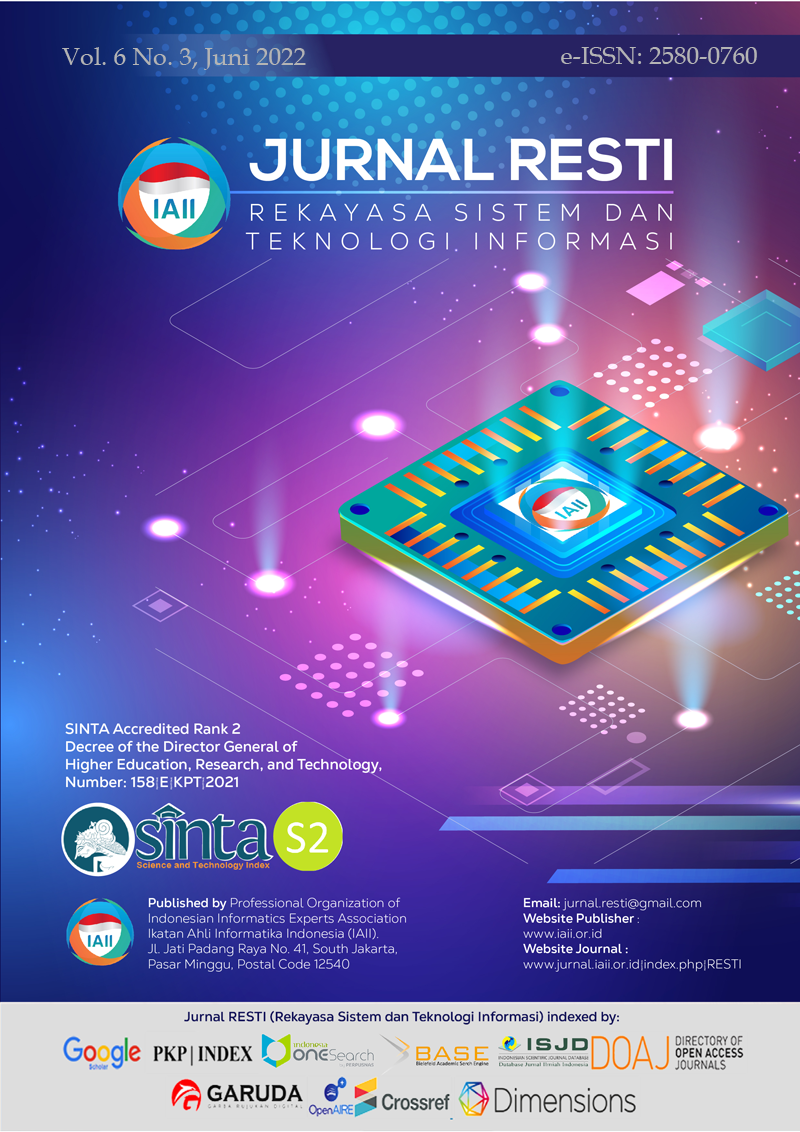Factors Affecting the PeduliLindungi User Experience Based on UX Honeycomb
Abstract
With background of Covid-19 pandemic, Indonesian state trying to make various efforts, so people comply health protocols. One of them is through PeduliLindungi application. PeduliLindungi has 3 main functions, namely tracing, tracking, warning and fencing. However, PeduliLindungi is deemed unable to meet user needs in terms of appearance and experience provided. This study aims to find factors that affect user experience in PeduliLindungi app based on UX Honeycomb. UX Honeycomb is a tool that can explain various aspects of user experience design in 7 indicators and grouped into 3 variables. The 3 variables are Think (useful, valuable, credible), Feel (desirable, credible), and Use (findable, accessible, usable). This study uses primary data by distributing online questionnaires to 404 respondents contains 15 statements that represent all UX Honeycomb variables, with 5 scales of answer choices namely strongly disagree/disagree/neutral/agree/strongly agree. From the calculation results, it is found that all variables and indicators significantly affect user experience with greatest level of influence being on the Think variable at 0,418, the second Use at 0,219, and the last is Feel at 0,151. Further research is expected can measure the level of influence on user experience by making direct comparisons with similar health apps.
Downloads
References
Menteri Kesehatan Republik Indonesia & Menteri Komunikasi dan Informatika Republik Indonesia, “Penyelenggaraan Sistem Informasi Satu Data Vaksinasi Corona Virus Disease 2019 (Covid-19),” web.kominfo.go.id/. 2021.
Kementerian Komunikasi dan Informatika Republik Indonesia, “PeduliLindungi,” PeduliLindungi.id, 2020. [Online]. Available: PeduliLindungi.id. [Accessed: 11-Sep-2021].
Kementerian Komunikasi dan Informatika Republik Indonesia, “PeduliLindungi,” 2021. [Online]. Available: https://play.google.com/store/apps/details?id=com.telkom.tracencare. [Accessed: 11-Sep-2021].
Nurhidayanti, Sugiyah, and K. Yuliantari, “Pengaturan Perlindungan Data Pribadi dalam Penggunaan Aplikasi PeduliLindungi,” Widya Cipta J. Sekr. dan Manaj., vol. 5, no. 1, pp. 39–45, 2021.
A. Mustopa, Hermanto, Anna, E. B. Pratama, A. Hendini, and D. Risdiansyah, “Analysis of User Reviews for the PeduliLindungi Application on Google Play Using the Support Vector Machine and Naive Bayes Algorithm Based on Particle Swarm Optimization,” in 2020 Fifth International Conference on Informatics and Computing (ICIC), 2020, pp. 1–7.
W. Sudiarsa and G. B. Wiraditya, “Analisis Usability pada Aplikasi PeduliLindungi Sebagai Aplikasi Informasi dan Tracking Covid-19 dengan Heuristic Evaluation,” J. Inf. Technol. Comput. Sci., vol. 3, no. 2, 2020.
P. Robin and G. Priscila, “Pengaisan Big Data & Dunia Kesehatan: ‘Analisis Penyalahgunaan Big Data dalam Usaha Pemerintah Indonesia di Masa Pandemi Covid-19,’” J. Public Corner Fisip Univ. Wiraraja, vol. 16, no. 1, pp. 37–57, 2021.
A. A. Syahidi and H. Tolle, “Evaluation of User Experience in Translator Applications (Banjar-Indonesian and Indonesian-Banjar) Based on Mobile Augmented Reality Technology using the UX Honeycomb Method,” J. Games, Game Art, Gamification, vol. 6, no. 1, pp. 7–13, 2021.
CNN, “Kominfo: 32,8 Juta Penduduk Indonesia Unduh PeduliLindungi,” CNN Indonesia, 2021.
Kementerian Pendayagunaan Aparatur Negara dan Reformasi Birokrasi, “Pemerintah Perluas Penggunaan Aplikasi PeduliLindungi ke Luar Jawa-Bali,” PANRB. 2021.
P. K. Arieska and N. Herdiani, “Margin Of Error Between Simple Random Sampling And Stratified Sampling,” in PROCEEDING International Conference Technopreneur and Education 2018, 2018, vol. 1, no. 1, pp. 408–412.
R. N. K. Azis, “Gambaran Kejadian Berat Bayi Lahir Rendah Berdasarkan Paritas dan Usia Ibu Saat Hamil di RSUD Wates Bulan Desember 2018.” 2019.
W. Kusuma, R. I. Rokhmawati, and M. T. Ananta, “Evaluasi Pengalaman Pengguna pada Aplikasi Mobile Learning dengan menggunakan UX Honeycomb,” J. Pengemb. Teknol. Inf. dan Ilmu Komput., vol. 3, no. 6, pp. 5756–5764, 2019.
D. Dalli, “The UX Lenses,” Damiendalli. 2020.
D. P. Wicaksono, “Evaluasi User Experience E-Supply Chain pada Area Distribusi Jasa Pengiriman dengan Metode UX Honeycomb.” 2020.
A. N. K., “Perbandingan Pengaruh User Experience pada Situs Terhadap Citra Merek Pada Pengguna Goal-Directed dan Pengguna Experiential (Studi Eksperimen pada Situs www.hellosoursally.com Terhadap Citra Merek Sour Sally),” Universitas Indonesia, 2012.
E. U. N. Sholiha, “Structural Equation Modeling-Partial Least Square Untuk Pemodelan Derajat Kesehatan Kabupaten/Kota di Jawa Timur (Studi Kasus Data Indeks Pembangunan Kesehatan Masyarakat Jawa Timur 2013),” Institut Teknologi Sepuluh Nopember, 2015.
J. Sarwono, Mengenal PLS-SEM. CV. Andi Offset, 2012.
S. Yamin, Tutorial Statistik Lengkap 1000 Halaman Dengan Software SPSS, 1st ed. Titian Pena Abadi, 2016.
Garson, Partial Least Squares : Regression & Structural Equation Models. Statistical Publishing Associates, 2016.
J. F. J. Hair, M. Page, and N. Brunsveld, Essential of Business Research Methods, 4th ed. Apex CoVantage, LLC, 2020.
A. A. Wala, “Penggunaan Metode Structural Equation Modeling Untuk Analisis Faktor yang Mempengaruhi Kualitas Pelayanan Perpustakaan Universitas Bhayangkara,” Universitas Bhayangkara, 2020.
Copyright (c) 2022 Jurnal RESTI (Rekayasa Sistem dan Teknologi Informasi)

This work is licensed under a Creative Commons Attribution 4.0 International License.
Copyright in each article belongs to the author
- The author acknowledges that the RESTI Journal (System Engineering and Information Technology) is the first publisher to publish with a license Creative Commons Attribution 4.0 International License.
- Authors can enter writing separately, arrange the non-exclusive distribution of manuscripts that have been published in this journal into other versions (eg sent to the author's institutional repository, publication in a book, etc.), by acknowledging that the manuscript has been published for the first time in the RESTI (Rekayasa Sistem dan Teknologi Informasi) journal ;








